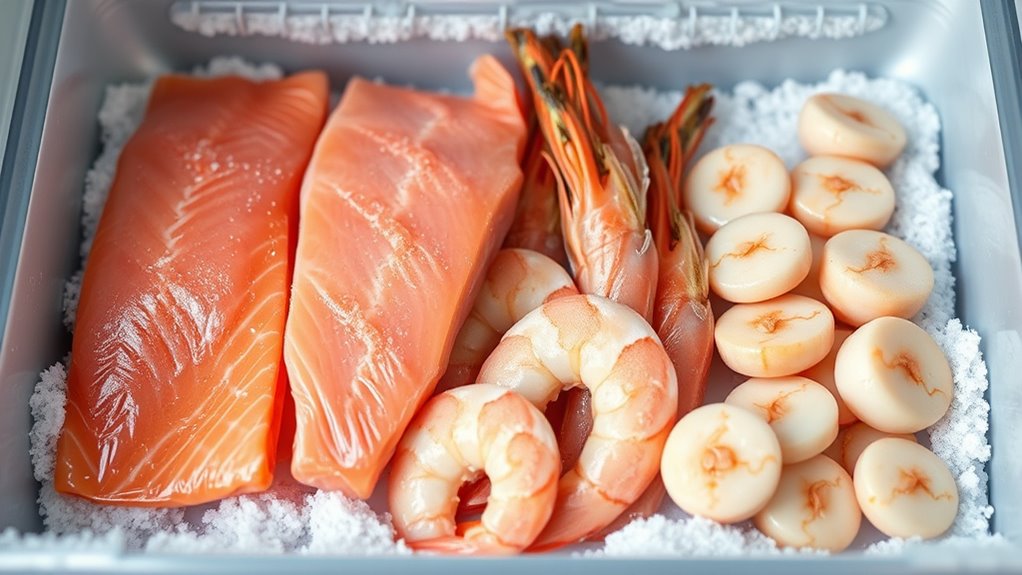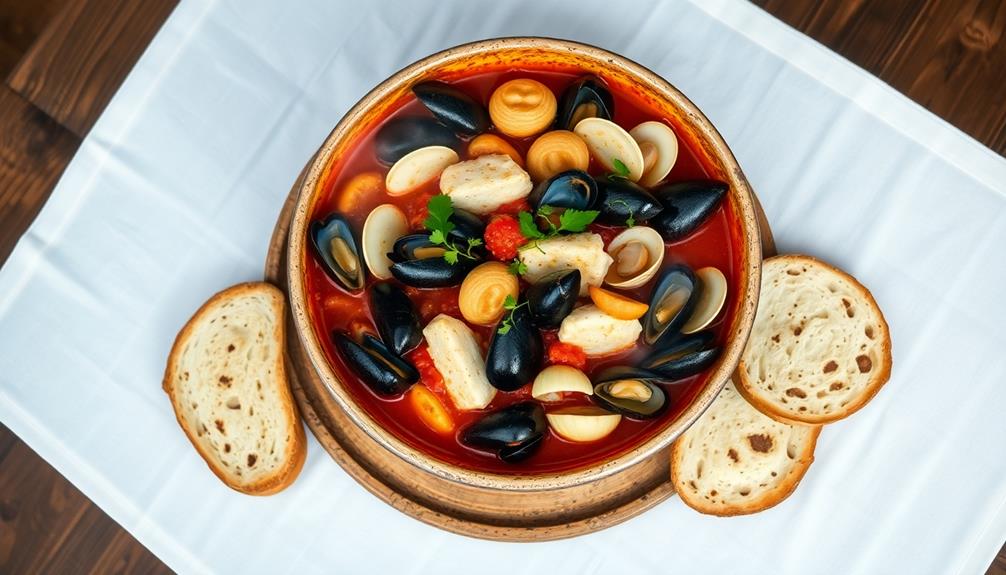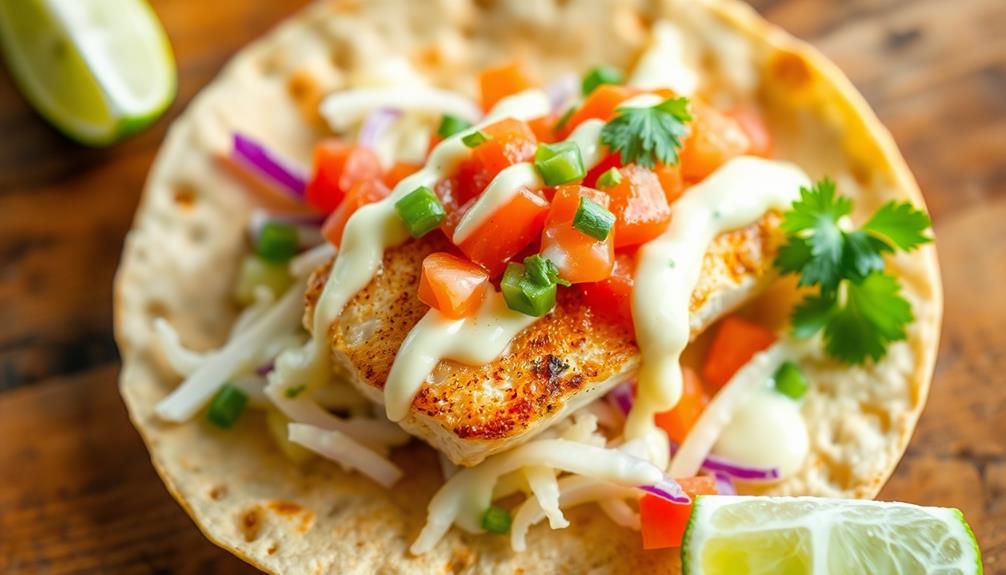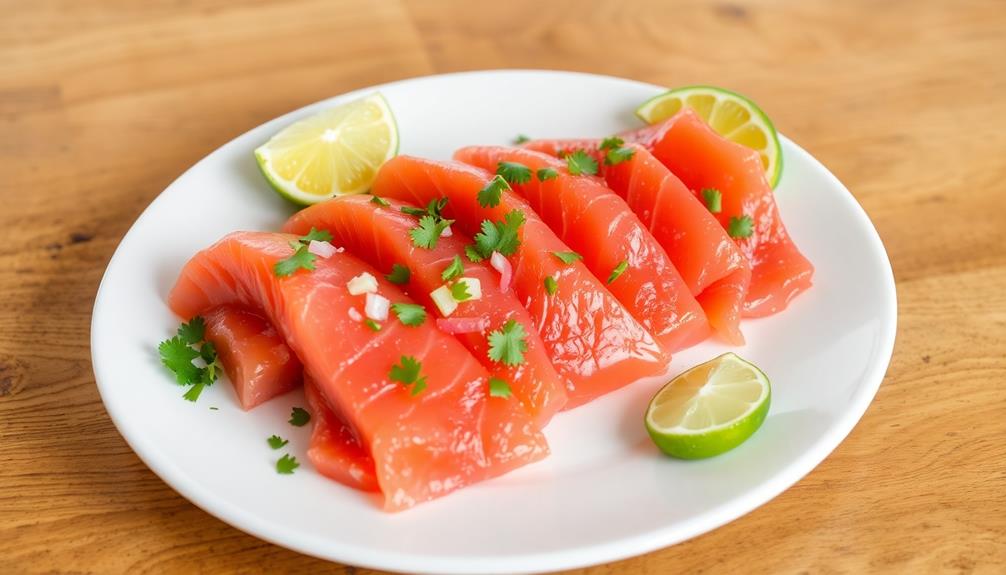To prevent freezer burn when storing fresh seafood, make sure to wrap it tightly using airtight, moisture-resistant materials like plastic wrap, aluminum foil, or freezer paper. For extra protection, double-wrap with plastic and foil, and remove as much air as possible before sealing. Proper packaging keeps moisture in and unwanted air out, preserving flavor and texture longer. Keep your seafood safe and fresh—discover more tips on optimizing your freezer storage.
Key Takeaways
- Wrap seafood tightly with moisture-resistant materials to eliminate air pockets and prevent freezer burn.
- Use vacuum sealing to remove excess air and create an airtight barrier around the seafood.
- Double-wrap with plastic wrap and foil for enhanced protection against moisture loss and odor absorption.
- Ensure seafood is dry and properly packaged to maintain moisture balance and reduce ice crystal formation.
- Label packages with the freezing date and store at consistent, optimal freezer temperatures for maximum freshness.

Storing fresh seafood properly is essential to maintain its quality and guarantee safety. When you’re planning to keep seafood in the freezer, the goal is to prevent freezer burn, which can ruin texture and flavor. One of the most effective methods to do this is by using vacuum sealing. This process removes air from the packaging, creating a tight barrier that minimizes exposure to oxygen and moisture. By vacuum sealing your seafood, you considerably reduce the chance of freezer burn and preserve the freshness for longer periods. It’s a straightforward step that offers a noticeable difference in the quality of your stored seafood.
Along with vacuum sealing, proper wrapping is equally important. If you don’t have a vacuum sealer, you should still wrap your seafood carefully. Use airtight, moisture-resistant materials like heavy-duty aluminum foil, plastic wrap, or freezer paper designed for freezing. Wrap the seafood tightly, making sure there are no air pockets that can lead to dehydration and freezer burn. For added protection, consider double-wrapping—first with plastic wrap and then with foil—to create a more effective barrier. Proper wrapping ensures that the seafood stays fresh, maintains its moisture, and prevents the absorption of off-flavors from other foods in the freezer.
Additionally, choosing the right packaging can influence the effectiveness of your preservation methods, especially since balance of moisture and air impacts the overall quality of stored seafood by affecting how well it retains its appearance and texture. Maintaining the appropriate air and moisture balance is crucial because excess air can accelerate freezer burn, while too much moisture can cause ice crystal formation that damages cell structure. When you’re preparing seafood for storage, start by cleaning and patting it dry. Excess moisture can cause ice crystals to form, which damages the texture. Once cleaned, choose your preferred method: vacuum sealing or proper wrapping. If vacuum sealing, make sure the bag is sealed tightly and remove as much air as possible. If wrapping by hand, ensure the package is snug and airtight.
Adding a layer of proper packaging can further enhance preservation by reducing exposure to temperature fluctuations and preventing freezer odors from contaminating the seafood. Label your packages with the date of freezing so you can keep track of freshness and avoid keeping seafood in the freezer too long. Most seafood can be stored safely for several months, but quality diminishes over time, especially if not properly protected.
Frequently Asked Questions
How Long Can Fresh Seafood Be Stored in the Freezer?
You can store fresh seafood in your freezer for 3 to 6 months, depending on its type. Keep your freezer at 0°F (-18°C) or lower to maximize storage duration and prevent freezer burn. Proper packaging, like airtight containers or vacuum sealing, helps maintain quality. Check the seafood periodically for signs of spoilage, and always label packages with the date to make sure you consume it within the ideal timeframe.
What Types of Seafood Are Most Prone to Freezer Burn?
You should know that fatty fish like salmon and mackerel are most prone to freezer burn because their high fat content easily oxidizes. Shellfish, such as shrimp and scallops, are also vulnerable due to their delicate nature. These types of seafood spoil faster and develop freezer burn more quickly if not stored properly. To protect your seafood, guarantee it’s tightly wrapped and kept at a consistent freezing temperature.
Does Packaging Affect Seafood’s Freezer Burn Vulnerability?
Like a suit that shields a knight, packaging materials guard your seafood from the icy grip of freezer burn. You should choose airtight wraps or vacuum-sealed bags to create a formidable barrier against moisture loss and air exposure. Proper packaging is essential for freezer burn prevention, keeping your seafood fresh and flavorful. Investing in quality materials guarantees your catch remains pristine, even after months in the cold.
Can Marinating Seafood Before Freezing Prevent Freezer Burn?
Marinating seafood before freezing can help with flavor infusion, but it doesn’t prevent freezer burn. Marinating techniques add flavor and moisture, which might slightly protect against dehydration. However, to truly prevent freezer burn, focus on proper packaging and removing excess air. So, while marinating enhances taste, it’s not a reliable method for freezer burn prevention—use airtight containers or vacuum sealing for the best results.
What Are Signs Seafood Has Developed Freezer Burn?
You’ll notice signs seafood has developed freezer burn through visual cues like white or grayish spots and ice crystals on the surface. Texture changes are also common, making the seafood feel dry, tough, or leathery instead of firm and moist. These indicators mean the seafood has been exposed to air and dehydration, affecting quality and taste. If you see or feel these signs, it’s best to avoid eating that seafood.
Conclusion
By following these freezer burn prevention tactics, you’ll keep your seafood as fresh as the ocean breeze. Think of proper storage like a gentle guardian, shielding your catch from harsh air and ice crystals. With a little extra care, your seafood stays flavorful and delightful, just like it was caught yesterday. So, treat your seafood right, and you’ll always enjoy the freshest taste, making every meal feel like a seaside feast.









